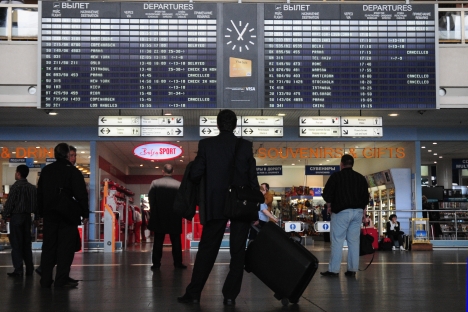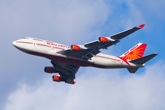
There are actually two distinct classes of airline carriers in Russia - those that use Western-built jets, and those that don't. Source: ITAR-TASS
An airplane, said psychologist Alexei Gervash, is one of the scariest places in the world: one where all human fears are accumulated together.
“If someone has a fear of heights, the aircraft is at the highest height,” Gervash told The Moscow News. “If you have claustrophobia, the aircraft is the closest place - you have no chance to escape. If you feel you have to be in control all the time, well, there is not even the illusion of control on an aircraft!”
Statistics show that about 30 percent of people experience fear or anxiety about flying. That's why, in June, Gervash partnered with Transaero Airlines to open an aerophobia treatment centre, Flying Without Fear (Letat Bez Strakha), in Terminal E of Sheremetyevo Airport.
Any ticketed passenger working up a cold sweat about launching 10,000 metres above the ground can go to the centre to watch a free DVD counseling course, practice his landing/takeoff game faces in a flight simulator, or consult a psychologist.
Aerophobia treatment programs have popped up all over the world over the last decades. But do flyers in Russia have more reason for anxiety than in other countries?
Just last Friday, an Antonov An-26 airplane carrying 45 people had to make an emergency landing in eastern Siberia after one of its engines stalled. In fact, a total of 30 planes crashed in Russia last year, killing 114 people.
In 2011, Russia and the CIS region had the worst overall air safety record in the world, as tracked by the International Air Transport Association (IATA). Measuring the number of hull losses (a crash that renders the aircraft irreparable) per million sectors (a flight that includes a takeoff and a landing), the Russia-CIS region suffered a total accident rate of 8.19 hull losses per million sectors, compared to 6.17 in Africa and 1.33 in North America.
This doesn't mean that it's time to start taking the train to Kamchatka, though: aviation experts say statistics can be misleading.
“There is no such thing as [an overall matrix] of Russian aviation safety,” Yury Karash, a journalist and pilot, told The Moscow News. “Aeroflot, for example, is one of the world's safest airlines, but you can't generalize about overall aviation safety based only on Aeroflot.”
There are actually two distinct classes of airline carriers in Russia - those that use Western-built jets, and those that don't.
Aeroflot, for example, flies mainly Western-made Boeings or Airbuses, which are leased, not purchased. According to the lease, Karash said, these aircraft have to be regularly checked and serviced abroad.
As maintenance is strictly regulated and international standards of personnel training and safety are tightly managed, these types of planes are typically quite safe. When counting crashes of Western-built jets only, the IATA's accident rate in Russia and the CIS in 2011 falls to just 1.06 hull losses per million sectors. In 2012, it was 0: the same as North America, and better than Europe's 0.15.
Look out below
Incidents with non-Western-built jets, used by many of Russia's 100-odd regional airlines, now comprise the overwhelming majority of today's airplane accidents.
Russia's smaller air carriers first developed a reputation for being downright dodgy in the 1990s.
“I took my seat on the flight back to Moscow next to two very jolly young men,” wrote Paul Bradbury, a travel author, blogging about his experiences living in Russia in the 1990s. “I soon caved in to their demands to share the [vodka] bottles they had with them. Over the three bottles we drank on the flight (and they had started a long time before me), they told me about the imminent wedding for one of them, how he was off to Kiev via Moscow for a final fling.”
“The other inebriate was escorting him as far as Moscow before catching the turnaround flight, as he had to start work in nine hours,” Bradbury wrote. “I asked him what he did. ‘I am a pilot. I will be flying this plane to Tashkent. Cheers!’”
Drunk pilots, cut corners, flagrant disregard for safety procedures - anecdotal evidence of the dubious nature of regional aviation back in the day abounds. Though the situation certainly has improved, many safety concerns still remain.
Non-Western-made planes themselves can be unsafe, some having reached or surpassed their recommended usage lifespan, in addition to sometimes being poorly or sporadically maintained. But technical failure is relatively rare. Russia's Interstate Aviation Committee (MAK) concluded that only 20 percent of aviation accidents in 2012 were caused by equipment malfunction.
The real concern, pilot and journalist Karash said, lies in the so-called human factor.
“In the world, up to 50 percent of aviation accidents are caused by the human factor,” he said. “In Russia, this number reaches up to 80 percent.”
MAK's analysis of crash causes over the last several years agreed that “the majority of incidents were due to gross violations of flight operations, pilot training and aircraft operations,” it wrote in a 2011 report posted on its website.

Travelling to Moscow? Beware of Air India
India, Russia look to increase air connectivity
Russia eyes regional transport aircraft partnership with India
The “human factor” can mean negligence as well as lack of experience, said Roman Gusarev, an aviation analyst and editor of Avia.ru.
“There are a large number of young pilots who don't have a great deal of flying experience,” he told The Moscow News. “This contributes to the number of air accidents in Russia.”
MAK has noted systematic problems in pilot training, which appear to stem from cost-saving efforts.
“Financial saving in training of flight personnel leads to the dispatch of pilots who don't meet qualification requirements,” it wrote in an analysis of the last 20 years of Russian aviation safety on its website.
Airline personnel are also frequently overworked. Russia is now in the throes of a severe shortage of qualified pilots. The country produces 650 pilots through its state-run training system every three to five years, yet the domestic industry alone needs about 800 new recruits every year, noted Avia Solutions Group, a Lithuanian organization of aviation-related companies.
“Satisfying this demand has obliged regulatory authorities to extend the maximum annual flying hours of already-overworked pilots,” Avia Solutions wrote on its website.
The growing deficit has led to a salary war between Russian airlines to attract experienced pilots. It's a competition that small regional carriers simply can't afford, which leaves them with greener staff - and a higher accident rate.
Wanted: pilots
The Air Code currently bans the hiring of foreign pilots, a provision that the Transportation Ministry is pushing hard to reverse in order to help relieve the pilot shortage. The idea is nearing fruition. The Economic Development Ministry published a plan earlier this month that would allow quotas for hiring foreign pilots based on airline traffic.
Reducing the pilot deficit would help reduce carrier costs, relieve overworked airline personnel, and better distribute experienced pilots among airlines.
Russia's pilot woes are an issue of quality as well as quantity, with better staff needed to raise the overall safety record.
“There is no other way to [decrease accidents] but to give adequate training to Russian personnel and hold them responsible for what they're doing - that's it,” Karash said.
MAK has additionally recommended that all Russian airlines undergo the IATA's production audit, called IOSA, to receive a certificate for compliance with operational safety guidelines.
So far, only 24 of Russia's hundred-plus airlines have received an IOSA certificate.
First published in The Moscow News.
All rights reserved by Rossiyskaya Gazeta.
Subscribe
to our newsletter!
Get the week's best stories straight to your inbox